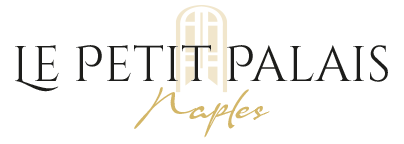
-
Pedamentina San Martino 38
80129 Napoli
- +39 335 105 1108 / +39 329 114 8016
- lepetitpalaisnaples@gmail.com
Copyright © 2022 Le Petit Palais – Naples
Designers by Wisuall
Commissioned in 1325 by Charles of Anjou on the top of the hill of Sant’Erasmo, the master architect of the court Tino from Camaino worked on its construction, it was dedicated to Saint Martino of Tours only in the sixteenth century.
It has been interested by important restoration and expansion works in the 17th century; in this period are dated the majestic cycles of pictorial decoration and the sculptural apparatus entrusted to Pietro Bernini, among others. In the second half of the seventeenth century worked in the charterhouse the architect Cosimo Fanzago who gave the current baroque appearance of the complex, while the painters who worked in this phase were the greatest artists of Neapolitan painting of the seventeenth century: Massimo Stanzione, Jusepe de Ribera, Luca Giordano, Battistello Caracciolo, Paolo Finoglio and the emilian Guido Reni and Giovanni Lanfranco.
The charterhouse is absolutely one of the largest religious monumental complexes in the city and one of the most successful examples of Baroque architecture and art together with the real chapel of Saint Gennaro Treasure, as well as the fulcrum of Neapolitan painting of the seventeenth century.
The complex is formed by about one hundred rooms, two churches, a courtyard, four chapels, three cloisters and hanging gardens. Chronologically it is the second charterhouse in Campania having been born nineteen years after that of Saint Lorenzo in Padula and forty-six before that of Saint Giacomo in Capri.
The ‘Cuciniello’ nativity scene, named by its creator, represents one of the finest examples of Neapolitan nativity scene of the 18th century.
It is inextricably linked to the history and will of its author who, in order to donate it to the museum, claimed to independently set up the scenography of the work.
The architect created a “rock” dividing it into three parts that, whoever observes the nativity scene, can immediately distinguish. The three areas respectively represent the main scenes represented in this traditional jewel of Neapolitan craftsmanship: the Annunciation, the Nativity and the tavern. The nativity, in particular, follows the tradition of the eighteenth century, and is set in a ruin of a Roman temple. Those were the years in which Fiorelli, a dear friend of Cuciniello, was particularly active on the front of the excavations in Pompeii and Herculaneum and the cave sculpted by Cuciniello takes up the structure of these great archaeological sites in Campania.
Monday-sunday: 8.30am – 7.30pm
Closed: wednesday
Ticket: 6 euro

Copyright © 2022 Le Petit Palais – Naples